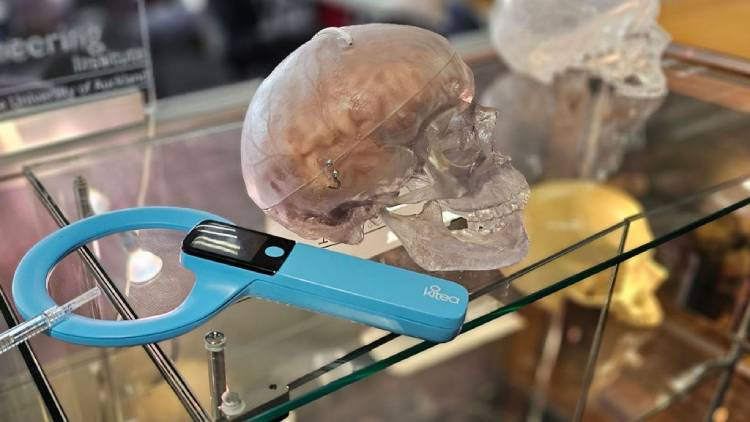Wireless Brain Sensor Trial Marks Medical Breakthrough
06-02-2025 | By Robin Mitchell

Wireless brain sensor and wand technology could transform hydrocephalus care.
While traditional hydrocephalus treatments rely on shunts that can be prone to failure, the need for more reliable, patient-friendly solutions has led to the exploration of novel medical implants. Recently, doctors in Auckland have begun testing a wireless brain sensor that could transform the way hydrocephalus is monitored by allowing patients to detect potentially life-threatening pressure changes at home.
Key Things to Know:
- Wireless brain sensors are transforming hydrocephalus care: A groundbreaking trial in Auckland is testing a wireless brain sensor designed to monitor brain pressure in real-time, reducing reliance on hospital visits.
- Traditional shunts have a high failure rate: Around 50% of shunts fail within the first two years, often requiring emergency intervention. This new sensor provides early warnings to prevent critical complications.
- Cutting healthcare costs and improving patient safety: Studies indicate that 70% of emergency visits for suspected shunt failures are false alarms. Real-time monitoring could significantly reduce unnecessary hospital admissions.
- Future applications beyond hydrocephalus: Researchers are exploring wireless implant technology for conditions like epilepsy and Parkinson’s disease, paving the way for broader neurological care innovations.
What challenges do brain implants face, what did the research team develop, and what are the implications of this wireless sensor for hydrocephalus patients—and potentially other neurological conditions—in the future?
The Challenges Of The Brain
While the brain cannot survive on its own, to say that it is the most important organ is by no means an understatement. The brain is what has allowed humanity to become the dominant species, enabling us to unravel the mysteries of the universe. Because of the importance of the brain, any medical condition that affects it can be devastating. In an electronic world where sensors are everywhere, you would think that we could attach sensors to this vital organ by now and get real-time data looking out for the first sign of trouble. However, just like any implant, trying to integrate sensors into the human brain presents many challenges.
Risk of Contamination and Infection
One such challenge is the risk of contamination, and thus, infection. The human brain is a sterile environment, and any foreign object that enters this space must be carefully sterilised. If this is not done, it is possible for bacteria and other foreign bodies to enter the brain and cause infection. This infection can quickly spread throughout the brain and cause serious damage, potentially leading to death. As such, any sensor that is to be implanted into the brain must be carefully sterilised before use, and this can be a difficult process to achieve.
Biocompatibility: Ensuring the Body Accepts the Sensor
Another challenge that faces sensor integration into the brain is that the materials used by the sensor must be biocompatible. This means that the sensor must be made from materials that the body can accept and not reject. If the sensor is made from materials that are not biocompatible, the body will recognise the sensor as a foreign object and try to reject it. This rejection can lead to inflammation and scarring around the sensor, which can cause serious damage to the surrounding tissue. As such, any sensor that is to be implanted into the brain must be made from materials that are biocompatible.
Powering Brain Implants: The Challenge of Energy Supply
In addition to the challenges of sterilisation and biocompatibility, sensors implanted into the brain also need to have a reliable source of power. While it is possible to use wireless power to provide energy to the sensor, this is not always reliable. Wireless power can be affected by many factors, including the distance between the power source and the sensor, the presence of other objects in the area, and the type of materials used to construct the sensor. As such, sensors that are implanted into the brain often require a reliable source of power that is not affected by external factors.
Even if a reliable source of power can be found, the data being recorded by the sensor must also be interpreted and acted upon. This can be a challenging task, as the brain is a highly complex organ that is still not fully understood. While it is possible to record data from the brain, it is much more difficult to interpret the meaning of that data. For example, it may be possible to record electrical activity in the brain, but it may not be clear what that electrical activity represents. As such, any sensor that is to be implanted into the brain must be able to record data that can be reliably interpreted, and this can be a challenging task.
Historic Trial of Wireless Brain Sensor for Hydrocephalus Patients Underway
In a groundbreaking medical trial, a child has become the first to be fitted with a wireless brain sensor designed to monitor potentially life-threatening pressure changes in individuals with hydrocephalus. The innovative technology, developed by researchers at the Auckland Bio-Engineering Institute and spin-off company Kitea Health, has the potential to revolutionise the management of this debilitating condition.
While this marks a significant milestone, experts highlight the importance of continuous monitoring in hydrocephalus management. A major issue with traditional shunts is their high failure rate—approximately 50% fail within the first two years, necessitating urgent medical intervention. This wireless sensor addresses the gap by allowing real-time, non-invasive pressure readings, ensuring that parents and patients can detect potential failures before symptoms become critical.
How the Wireless Brain Sensor Works
The wireless sensor, which is implanted into the skull next to the drainage shunt, is a small glass rectangle with a strip of electronics inside. It weighs just 0.3 grams and is 20mm long, 2mm by 3mm wide. The device is powered by an external "wand" that is waved over the person's skull to take a brain pressure reading. This reading is then displayed to the individual or their parent, allowing them to determine whether the pressure is raised, indicating a possible shunt failure, or normal, indicating that something else is causing their symptoms.
The design of the sensor reflects years of innovation in biomedical engineering. Unlike traditional wired implants, which pose risks of infection and mechanical failure, this wireless device eliminates the need for tethered components. By leveraging a power-efficient, wand-activated system, the sensor can operate without requiring invasive surgical adjustments, significantly reducing post-operative complications.
Addressing the Limitations of Traditional Shunts
The sensor is a significant advancement in the treatment of hydrocephalus, a condition that causes fluid to build up in the brain. Current treatments involve the use of shunts, which are small tubes that drain the excess fluid into the abdomen. However, these shunts have a major flaw: they can easily become blocked, particularly in children. When this occurs, it can lead to raised brain pressure, potentially causing irreversible damage or even death. The symptoms of a blocked shunt, such as headaches, nausea, and irritability, can be difficult to distinguish from other conditions, making it challenging for doctors to determine whether a shunt failure has occurred.
Real-Time Brain Pressure Monitoring: A Game Changer
The new sensor addresses this issue by providing real-time monitoring of brain pressure. By eliminating the need for frequent hospital visits and scans, the sensor has the potential to reduce healthcare costs by 30%. Additionally, the sensor's ability to monitor brain pressure in real-time allows for early detection of shunt failures, potentially preventing long-term damage and reducing the risk of death.
Economic Impact of Wireless Brain Sensors
Beyond its clinical benefits, the device introduces a transformative shift in healthcare economics. Current hydrocephalus management involves costly CT scans, MRIs, and hospital admissions, with emergency visits often occurring due to false alarms. Research suggests that approximately 70% of emergency visits for suspected shunt failures turn out to be unnecessary, adding strain to healthcare systems. By equipping patients with real-time monitoring capabilities, this technology not only enhances patient safety but also significantly reduces the burden on medical infrastructure.
Current Trials and Future Expansion
The trial, which involves approximately 20 adult and child patients, is currently underway in Auckland City Hospital. The sensor has already been tested in sheep at the University of Auckland's Ngapouri Research Farm, demonstrating its safety and efficacy. The next phase of the trial, a pivotal trial involving 150 patients in Aotearoa and the US, is expected to begin in early 2026. Once completed, the company plans to apply for regulatory approval in the US, with a strong possibility of receiving approval in New Zealand sooner.
With global trials expanding, regulatory approval remains a key milestone for the widespread adoption of this technology. New Zealand is positioned as a leader in this space, with the potential to secure early regulatory approval based on the results of the ongoing pilot studies. Additionally, international collaborations, such as those with the University Health Network in Canada, indicate growing interest in this technology for applications beyond hydrocephalus, including neuro-monitoring for stroke and traumatic brain injury patients.
Potential for Transforming Neurological Care
The development of this wireless brain sensor represents a significant breakthrough in the field of neurology and has the potential to transform the lives of individuals with hydrocephalus. By providing real-time monitoring of brain pressure, the sensor offers a new level of precision and accuracy in the management of this condition, potentially reducing the risk of long-term damage and improving patient outcomes.
Experts believe that advancements in implantable sensor technology could pave the way for future applications beyond hydrocephalus. Researchers are already exploring miniaturised, wireless implants capable of monitoring conditions such as epilepsy and Parkinson’s disease, where real-time brain activity tracking could revolutionise treatment protocols. The ability to remotely assess brain function opens possibilities for personalised treatment strategies, minimising hospitalisations while improving patient outcomes.
Could Implanted Sensors Become The New Norm?
While the concept of living forever may be a distant dream for many, the notion of preventing premature death is a universal aspiration that transcends cultures and generations. In an era where technological advancements are transforming our world at an unprecedented rate, the integration of sensors into the human body presents a promising avenue for ensuring that every individual has the opportunity to live a long, healthy, and fulfilling life.
The importance of early detection in combating diseases cannot be overstated. In many cases, cancers that are caught in their infancy can be eradicated with ease, while conditions such as diabetes and heart disease can be effectively managed with prompt intervention. The integration of sensors into the human body could play a pivotal role in identifying potential health issues before they escalate into life-threatening conditions. By providing real-time monitoring and tracking of vital signs, these sensors could empower individuals to take proactive steps towards maintaining their health and well-being.
One of the most tragic consequences of premature death is the loss of young lives, whose stories often leave a lasting impact on families and communities. The integration of sensors into the human body could help mitigate this issue by providing early warnings of potential health risks, thereby enabling timely interventions and preventing avoidable fatalities. For instance, sensors capable of detecting subtle changes in blood glucose levels could alert individuals with diabetes to adjust their medication or lifestyle habits, thereby preventing severe complications.
While some may lament the impact of technological advancements on our society, including the rise of artificial intelligence and the threat of job displacement, the potential benefits of these technologies cannot be ignored. If these advancements ultimately lead to a future where no child ever dies from preventable diseases, it would be a future worth striving for. The integration of sensors into the human body presents a compelling opportunity to transform our understanding of health and wellness, and to create a world where every individual has the chance to live a long, healthy, and fulfilling life.

